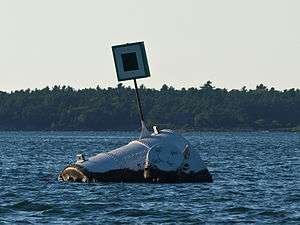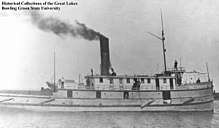Metamora (tug)
The Metamora was a wooden tug commissioned in 1864 and used predominantly for ferrying passengers and goods in the Georgian Bay area of Ontario. It ran onto a shallow shoal near Turning Island in Georgian Bay on July 30, 1907, caught fire and sank in six feet of water.[2]
 Metamora Wreck The above-water remains of the wreck of the tug Metamora. Visible is the ship′s boiler, which has been painted white and has a channel marker attached to it as a hazard warning. | |
| History | |
|---|---|
| Name: | Metamora |
| Builder: | Peck & Masters, Cleveland |
| Completed: | 1864 |
| Fate: | Ran into a shallow shoal off of Turning Island, Georgian Bay, September 29, 1907[1] |
| Status: | Sunk |
| General characteristics | |
| Class and type: | Tug |
| Tonnage: | 300 tons |
| Length: | 121 feet |
| Beam: | 21 feet |
| Installed power: | Steam |
She was constructed at the Peck & Masters shipyard in Cleveland, Ohio in 1864.[1] The ship was 121 feet long, and 21 feet wide, and displaced about 300 tons.[1] The Metamora was originally fitted out with armour-plating and a cannon, and was tasked with patrolling the waters of what was then Upper Canada for Fenian raiders.[2] These were removed in the 1870s, when the Fenian threat had diminished, and the Metamora then plied the waters of Georgian Bay as a freighter and passenger vessel.[2] It was being used primarily as a logging tug boat, by the Burton Bros. of Collingwood in 1895, Midland lumbermen James Playfair & Company purchased the Metamora along with three barges and a large quantity of boom logs, for use in connection with their lumbering business.[3]
Sinking and wreck

On September 29, 1907 the Metamora was towing a boom, bound for the mill town of Byng Inlet, when she struck a shallow shoal just west of Turning Island, relatively near Pointe au Baril. She caught fire and sank in shallow water, with all of her crew and passengers surviving by swimming the relatively short distance to shore.[2] The Metamora was owned by the Midland Towing and Wrecking Co.[4]
For many years afterward a portion of the upper deck that did not burn was visible above the water. Currently the Metamora's boiler is the only portion of the ship that can still be seen above the surface. It is known locally as "The Wreck".[2] The boiler has been painted white and a channel marker has been attached to it as a hazard warning for the boats that travel in this area. The shallow waters have also made the ship a favourite haunt for scuba divers.[5] The wreck is located at 45°31′43.39″N 80°24′26.61″W.
Notes
- "Metamora". BGSU. Archived from the original on 2012-12-14. Retrieved 2010-08-29.
- Curtis, Andrea (May 11, 2004). "Into the Blue". Into the Blue. Retrieved 2010-08-29.
- The Canada Lumberman magazine, February 1895
- The Railway And Marine World magazine, May 1907
- "Parry Sound Public Library, Wrecks: The "Metamora"". Parry Sound Public Library. Archived from the original on 2012-12-14. Retrieved 2010-08-29.
External links
- Bowling Green State University, Historical Collections of the Great Lakes: Vessel Images, Metamora
- Great Lakes Shipwrecks M: Metamora
- Lost Magazine October 2008: Maritime History-Growing up with a shipwreck
- Panoramio: Aerial photograph of the wreck site
- Parry Sound Public Library, Wrecks: The "Metamora"